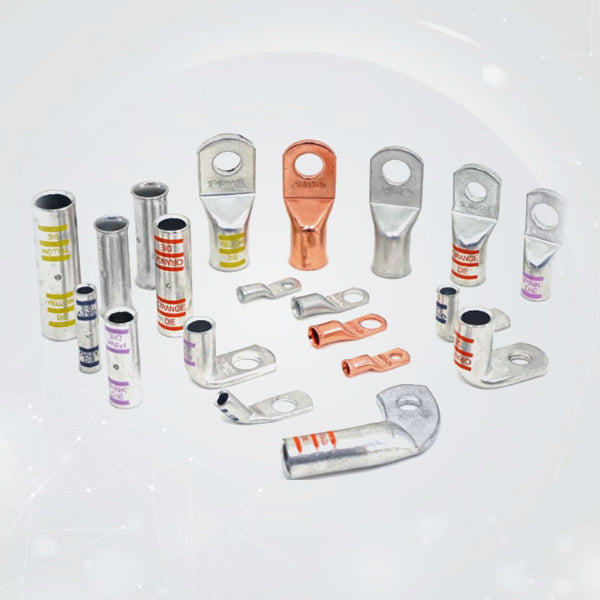
Understanding the Specifications of 6 Gauge Tinned Lugs: A Detailed Guide
When it comes to managing moderate current levels in electrical systems, choosing the right connector is critical. This is especially true in environments where exposure to moisture, chemicals, or salt may compromise the performance and safety of your connections. 6 AWG tinned lugs stand out as a reliable solution in such conditions. These connectors are not only known for their strength and conductivity but also for their resistance to corrosion, thanks to their tin-plated finish.
Whether you're an installer, technician, or engineer, understanding the specifications of 6 gauge tinned lugs is essential for ensuring long-term performance, safety, and reliability. In this comprehensive guide, we’ll take a closer look at what makes these lugs unique and why they’re an important part of your electrical toolkit.
What Are 6 Gauge Tinned Lugs?
6 AWG tinned lugs are mechanical connectors specifically designed to terminate 6 gauge wire lugs. The term "AWG" refers to American Wire Gauge, a standardized system that defines the diameter of electrical wires. A 6 AWG wire has a relatively thick cross-section, making it suitable for moderate to high current loads.
The "tinned" aspect refers to the thin layer of tin plating over the copper body of the lug. This tin coating plays a crucial role in enhancing corrosion resistance—particularly important in marine, industrial, or outdoor applications where bare copper could degrade over time.
By providing both mechanical support and electrical conductivity, these lugs form an integral part of battery cables, distribution systems, and other medium-duty electrical setups.
Key Specifications of 6 Gauge Tinned Lugs
To ensure you choose the right product for your needs, it’s vital to understand the technical specifications that define the performance of 6 gauge tinned lugs.
1. Gauge Size Compatibility (6 AWG)
The most fundamental aspect is its compatibility with 6 awg wire lugs. A lug designed for this gauge ensures that the internal barrel diameter perfectly matches the wire size, allowing a snug fit. This compatibility is crucial for minimizing resistance and maintaining optimal current flow.
Using a lug not matched to the wire size can result in loose connections, increased resistance, and potential heat buildup—factors that can lead to failures over time.
2. Material Composition
High-quality 6 AWG lugs are typically manufactured from 99.9% pure copper, a material chosen for its excellent electrical conductivity and mechanical strength. Copper allows for efficient power transfer, while also withstanding mechanical stress during crimping or vibration during use.
To further improve their durability, these copper lugs are electroplated with a layer of tin. Tin is less reactive than copper and helps to reduce oxidation, thus extending the lifespan of the lug—especially in humid or corrosive environments.
3. Tin Coating Thickness
The thickness of the tin layer plays a subtle but important role in the lug’s performance. Typically, the tin plating ranges from 3 to 5 microns. This thin but even coating forms a protective barrier against moisture, salt spray, and other corrosive agents.
A uniform coating not only improves durability but also enhances solderability if needed. In substandard products, uneven plating can lead to premature failure, especially in marine or industrial installations.
4. Voltage and Current Ratings
Depending on the application, 6 AWG tinned lugs are rated to handle a specific range of voltages and current levels. These ratings vary slightly between manufacturers, but most standard 6 AWG lugs can handle up to 65 amps or more, depending on temperature and insulation factors.
Always refer to the product datasheet and ensure that the lug you choose can safely handle the electrical load of your system. Overloading a lug beyond its rated capacity can result in excessive heating, deformation, or even fire hazards.
5. Dimensional Specifications
Precision in physical dimensions is key to ensuring compatibility with terminals, bus bars, and cable sizes. Important dimensions include:
- Barrel Length: Determines how much wire can be inserted and crimped.
- Stud Hole Size: Matches the bolt or screw size for secure fastening.
- Overall Lug Length: Affects how the lug fits into tight or complex layouts.
For example, a typical 6 AWG lug may feature a 5/16" or 1/4" stud hole and a compact profile that allows easy installation even in space-constrained panels.
6. Temperature Rating
6 gauge battery cable connectors are often subjected to varying thermal environments. Quality lugs come with temperature ratings of -40°C to 150°C or higher, depending on the insulation and usage.
This range ensures that the lug will not degrade or soften under high load or ambient temperatures and will remain durable in colder climates or engine bays.
7. Certifications and Standards
Look for lugs that meet UL (Underwriters Laboratories) or RoHS (Restriction of Hazardous Substances) standards. UL certification confirms that the lug has been tested for safety and performance. RoHS compliance ensures that the product is free of hazardous materials like lead or cadmium.
These certifications offer peace of mind that the product you're using is not only reliable but also environmentally responsible.
Why Are These Specifications Important?
Understanding and following these specifications offers multiple advantages:
- Performance: Correctly sized and coated lugs ensure minimal electrical loss and efficient power transfer.
- Safety: Proper material selection and thermal ratings help prevent overheating, arcing, and fire.
- Reliability: Corrosion resistance and dimensional accuracy ensure the connection remains stable over time.
- Compatibility: Dimensions and stud sizes that match your components help avoid installation issues and poor contact quality.
Installation and Usage Best Practices
Even the best lug won’t perform well if not installed properly. Follow these steps for safe and effective use:
- Cable Preparation: Strip the insulation carefully to match the lug barrel length. Ensure wire strands are clean and untwisted.
- Crimping: Always use a crimp tool rated for 6 AWG lugs. A poor crimp can result in loose connections and arcing.
- Inspection: Post-crimp, visually inspect the joint to ensure full barrel engagement and no protruding strands.
- Environmental Sealing: In wet or harsh settings, apply heat shrink tubing or dielectric grease to seal the connection from moisture ingress.
Technical Recap
- Gauge Size: 6 AWG
- Material: High-conductivity copper
- Tin Coating Thickness: 3–5 microns
- Temperature Rating: -40°C to 150°C (typical)
- Certifications: UL listed, RoHS compliant
Conclusion
6 awg tinned copper lugs might appear to be simple hardware components, but they are engineered to meet demanding electrical and environmental conditions. By understanding their specifications—including material, coating, dimensions, ratings, and certifications—you’ll be better equipped to make informed decisions for your projects.
Whether you're wiring up a marine battery, an off-grid solar system, or an industrial power panel, choosing the right lug means ensuring safety, performance, and peace of mind.





